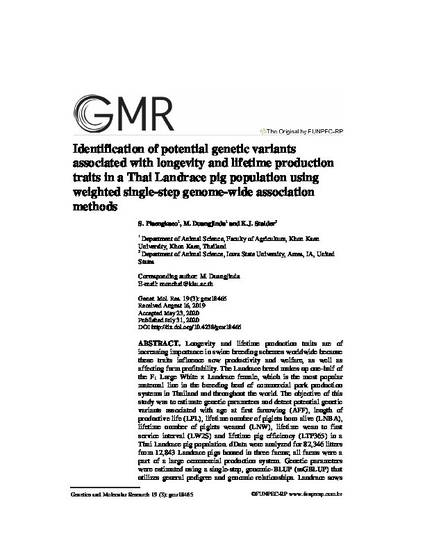
Longevity and lifetime production traits are of increasing importance in swine breeding schemes worldwide because these traits influence sow productivity and welfare, as well as affecting farm profitability. The Landrace breed makes up one-half of the F1 Large White x Landrace female, which is the most popular maternal line in the breeding herd of commercial pork production systems in Thailand and throughout the world. The objective of this study was to estimate genetic parameters and detect potential genetic variants associated with age at first farrowing (AFF), length of productive life (LPL), lifetime number of piglets born alive (LNBA), lifetime number of piglets weaned (LNW), lifetime wean to first service interval (LW2S) and lifetime pig efficiency (LTP365) in a Thai Landrace pig population. dData were analyzed for 82,346 litters from 12,843 Landrace pigs housed in three farms; all farms were a part of a large commercial production system. Genetic parameters were estimated using a single-step, genomic-BLUP (ssGBLUP) that utilizes general pedigree and genomic relationships. Landrace sows were genotyped with 60K Illumina PorcineSNP60 BeadChip. The genotypes were analyzed by weighted single-step genome-wide association analyses. Heritability estimates for longevity and length of productive life traits were low and ranged from 0.01 to 0.11. The greatest genetic correlations between LPL with LNBA, LNW, LW2S and LTP365 ranged from 0.44 to 0.91. The greatest genetic correlations between LPL and LNBA, LNW, LW2S and LTP365 ranged from 0.44 to 0.91. Based on these results, genetic selection for LPL was not antagonistic with lifetime production. Twenty-seven candidate genes were identified as being associated with one or more traits evaluated in this Landrace pig population. Highlighted genes related to LPL, LNBA, LNW and LTP365 included TMLHE, PDHX and KCNJ6 on SSC13 in this pig population. This constitutes a list of candidate genes that could be incorporated into selection to improve sow longevity and lifetime production traits in the pig industry.
Available at: http://works.bepress.com/kenneth_stalder/250/

This article is published as Plaengkaeo, S., M. Duangjinda, and K. J. Stalder. "Identification of potential genetic variants associated with longevity and lifetime production traits in a Thai Landrace pig population using weighted single-step genome-wide association methods." Genet. Mol. Res 19 (2020): gmr18465. doi: 10.4238/gmr18465.